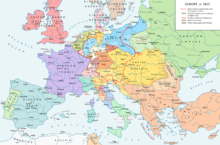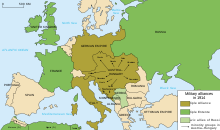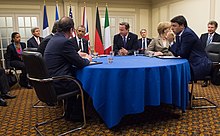European balance of power
TheEuropean balance of poweris a tenet ininternational relationsthat no single power should be allowed to achievehegemonyover a substantial part of Europe. During much of theModern Age,the balance was achieved by having a small number of ever-changingalliancescontending for power,[1]which culminated in theWorld Warsof the early 20th century.
History
[edit]Antiquity to Crusades
[edit]The emergence of city-states (poleis) inancient Greecemarks the beginning ofclassical antiquity.The two most important Greek cities, theIonian-democraticAthensand theDorian-aristocraticSparta,ledthe successful defense of Greeceagainst the invadingPersiansfrom the east, but then clashed against each other for supremacy in thePeloponnesian War.TheKingdom of Macedontook advantage of the following instability andestablished a single rule over Greece.Desire to form auniversal monarchybroughtAlexander the Greatto annex the entirePersian Empireand begin ahellenizationof the Macedonian possessions. At his death in 323 BC, his reign was divided between hissuccessorsand severalhellenistic kingdomswere formed.[2]
Romeexpanded into the whole ofItalyaround the same period and thenroseto prominence in the western andEastern Mediterraneanthrough thePunicandMacedonian wars,but was then shaken by acentury-long political crisis.Meanwhile, the popularity and wealth of Roman generals increased: notablyJulius Caesaracquired fame for projecting military power north of theAlpsintoGaul,east of theRhineintoGermaniaand across theEnglish ChannelintoBritain.A group of senators afraid of Caesar's title ofdictator for lifeassassinated him on theIdes of Marchof 44 BC. The adoptive son of Caesar,Octavian Augustus,defeated the killers of his father and became the firstRoman Emperor(Princeps) in 27 BC.[3]
TheRoman Empirepeaked during thePax Romana,stagnated during thecrisis of the third centuryAD and ultimatelysplitbetween theLatin Westand theGreek East.Both parts of the Empire abandoned paganpolytheismin order totoleratemonotheisticChristianityand finallymake it the state religion.The Westcollapsed around 476,following centuries ofattacks by Germanic and Slavic peoplesand several"barbarian" kingdomswere established on its former territory. The East continued to be ruled by theByzantine Empirefor an additional thousand years.[citation needed]
Among the successor kingdoms in the West, that of theFrankswas the largest, and underCharlemagnemanaged to unite most of present-day France, Germany, Switzerland, Austria, the Low Countries and Italy under one rule: he was subsequently crownedHoly Roman Emperorthe day of Christmas in 800 byPope Leo III.Meanwhile, theIberian peninsulafell underMuslimcontrol. The beginning of theReconquistaof Christian forces is traditionally dated to theBattle of Covadonga(718 or 722), in which anAsturianarmy achieved the first Christian victory over the forces of theUmayyad Caliphatesince the beginning of the military invasion.[4]Its culmination came in 1492 with thefall of the Nasrid kingdom of Granadato the united Spanish Crown ofFerdinand II of AragonandIsabella I of Castile.[5]The Germanic Emperor (Holy Roman Emperor) and theRoman Pontiff(Pope in Rome) came to be known as theuniversal powersof Europe, but then entered in conflict during theinvestiture controversyand theclash between their factions.Their rivalry made possible the birth of autonomouscity-states in northern Italyand the rise of an independentfeudal monarchyin France under theHouse of Capet.Around the same period, theNorsewas taking place with theNorman conquest of Englandhappening in 1066 andthat of Sicilyin 1130. With theHoly Landlost to Islam and the Byzantine Empire seeking help fromTurks,the Pope initiated thecrusadesagainst Muslims in an attempt to restore Christian unity following theEastern Schismof theOrthodoxfrom the Catholics.[6]
Most of the crusades did not achieve their objective, but some of them had a massive impact on the political and economic landscape of Europe: thefirst crusade(1099) re-opened the trade routes in the Mediterranean and ushered thecommercial revolution;thefourth crusade(1204) resulted in the formation of theVenetian maritime empire;and the sixth crusade (1228) temporarily madeFrederick II,heir of both theKingdom of Sicilyand theHoly Roman Empire,alsoKing of Jerusalem.At the same time, was taking place in the Iberian Peninsula and the kingdoms ofPortugal,CastileandAragonwere formed. A vast part of the French nobility took part in the crusades under the leadership of their king: this made possible the formation of a strong centralized French monarchy. The rise of medieval France began with theBattle of Bouvines(1224) and theAvignon Papacy(1309) but ended with the outbreak of theHundred Years' War(1337) with England and thereturn of the papacy to Rome(1378). After Europe recovered from theBlack Death,thegoldsmithJohannes Gutenberginvented the movable-type printing press, which started thePrinting Revolution.ARenaissancein art and science began in Italy and spread to the rest of the continent.[7]
Crusades to Westphalia
[edit]Portugal formed the first European colonial empire in 1415 with theconquest of Ceuta.In 1453, the French expelled theEnglish from their land,and theOttoman Turksconquered Constantinople,initiating the dominance of theOttoman Empirein Europe. At the end of the 15th century, following the marriage ofIsabella I of CastileandFerdinand II of AragonSpain wasdynastically unifiedandReconquistaconcluded successfully. Portugal and Spain, followed by France and England, ushered in theAge of Discovery.During the early 16th century, France and theHouse of Habsburgclashed during theItalian Wars.In 1519,Charles V of Habsburg,already Duke of Burgundy, King of Spain, and Archduke of Austria, became Holy Roman Emperor. After the defeat in theBattle of Pavia,Francis I of Franceallied with theMuslimOttomansultanSuleiman the Magnificent.After theannexation of the Aztec Empireandconquest of the Incas,Emperor Charles used the gold and silver coming from the Americas to finance the defence of his German territories in Austria from the Ottoman Empire (Siege of Vienna) and of his Italian territories in theDuchy of Milanfrom France (Battle of Pavia). In response, European rival states sanctionedprivateersto raid Spanish or Portuguese ships full of gold and silver, most especially in theCaribbean.Ultimately, Charles V conceded thePeace of Augsburgand abandoned his multi-national project with a series of abdications in 1556 that divided his hereditary and imperial domains between the Spanish Habsburgs, headed by his sonPhilip II of Spain,and theAustrian Habsburgs,headed by his brotherFerdinand.Ferdinand had been Archduke of Austria in Charles's name since 1521 and the designated successor as emperorsince 1531.[8][9][10]
The papacy launched theCatholic revivalin an attempt to halt the growth of Protestantism andOttoman expansion.Despite some successes, such as theBattle of Lepanto (1571)and theSiege of Paris (1590),theAnglo-Spanish Warand theLong Turkish Warquestioned the Catholic ambitions. Ultimately, the papacy lost its status and influence with theThirty Years' War(1618–1648) where the catholic french empire allied with the Protestant nations to defeat the Habsburg alliance. The Thirty Years War was one of the longest and most destructive conflicts in European history. Fought primarily inCentral Europe,an estimated 4.5 to 8 million soldiers and civilians died as a result of battle, famine, and disease, while some areas of what is now modern Germany experienced population declines of over 50%.[11]Related conflicts include theEighty Years' War,theWar of the Mantuan Succession,theFranco-Spanish War,theDutch-Portuguese Warand thePortuguese Restoration War.Many Protestant states also experienced a golden age: the newly independent Netherlands formed theDutch East India CompanyinIndonesia;Sweden formedan empire in northern Europe;and England began thecolonization of North America.By theTreaty of Westphaliaat the end of the Thirty Years' War, the Holy Roman Empire became a more decentralized entity in which constituent states, such as Prussia (which also had lands outside the Empire), were allowed to pursue their own foreign policy independent of that of the Austrian Habsburg Emperor. The Austrian Habsburgs also controlled some states outside of the Holy Roman Empire. It was France underLouis XIVwho took the status of main continental power from the Habsburgs thanks to theTreaty of Westphaliaand theTreaty of the Pyrenees.[12][13]
Stately quadrille
[edit]In the 16th and 17th centuries,EnglishandDutchforeign policystrove to prevent a creation of a singleuniversal monarchyin Europe, which many[14]believed France or Spain might attempt to create. To maintain the balance of power, the English and Dutch made alliances with otherstates—includingPortugaland the Holy Roman Empire—to counter the perceived threat. TheseGrand Alliancesreached their height in the wars againstLouis XIVandLouis XV of France.They often involved the English (later theBritish) and Dutch paying large subsidies to European allies to finance large armies.
In the 18th century, this led to thestately quadrille,with the major European powers of that century—Austria,Prussia,Great Britain,andFrance—changing alliancesmultiple times to prevent the hegemony of one nation or alliance. A number of wars stemmed, at least in part, from the desire to maintain the balance of power, including theWar of the Spanish Succession,War of the Austrian Succession,theSeven Years' War,theWar of the Bavarian Successionand theNapoleonic Wars.FollowingBritain's success in the Seven Years' Warduring which it was allied with Prussia, many of the other powers began to see Great Britain as a greater threat than France. Several states, most particularly France, entered theAmerican War of Independencein the hope of overturning Britain's growing strength by securing the independenceof the Thirteen coloniesofBritish America.[15]
19th century
[edit]
After the end of the Napoleonic Wars, during which France directly or indirectly controlled much of Europe except for Russia, and the Holy Roman Empire was dissolved, theConcert of Europetried to maintain the balance of power. The territorial boundaries agreed to by the victorious Great Powers (Prussia, Austria, Russia and Great Britain) at the Congress of Vienna in 1815 were maintained, and even more important there was an acceptance of the theme of balance with no major aggression.[16]Otherwise the Congress system says historian Roy Bridge, "failed" by 1823.[17]In 1818, the British decided not to become involved in continental issues that did not directly affect them. They rejected the plan of Tsar Alexander I to suppress future revolutions. The Concert system fell apart as the common goals of the Great Powers were replaced by growing political and economic rivalries.[18]Artz says the Congress of Verona in 1822 "marked the end."[19]There was no Congress called to restore the old system during the greatrevolutionary upheavals of 1848with their demands for revision of the Congress of Vienna's frontiers along national lines.[20]
Britain, with its naval, maritime, commercial and financial dominance, was committed to the European balance of power after 1815.[21]Between the 1830s and 1850, Britain and France were the strongest powers in Europe, but by the 1850s they had become deeply concerned by the growing power of Russia, which had expanded westward towards Central Europe, and Prussia, which was increasingly assuming greater control and influence over the German lands, aside from Austria. TheCrimean Warof 1854–55 and theItalian War of 1859shattered the relations among the Great Powers in Europe.[22]
The creation in 1871 and rise of the Prussian-ledGerman Empire(excluding Austria) as a dominant nation (Prussia had quickly defeated both Austria and France in wars) restructured the European balance of power. For the next twenty years,Otto von Bismarckmanaged to maintain the balance of power, by proposing treaties and creating many complex alliances between the European nations such as theTriple Alliance.[23][24][25]
World Wars
[edit]
After 1890, the German EmperorKaiser Wilhelm IIset out on his imperialist course ofWeltpolitik( "world politics" ) to increase the empire's influence in and control over the world.[26][27]Newly created alliances were proven to be fragile, something that triggered theFirst World Warin 1914 with Germany and Austria-Hungary on one-side against Great Britain, France, Italy and Russia (until 1917) on the other.[28]One of the objectives of theTreaty of Versailles,the main post-World War I treaty, was to abolish the dominance of the 'Balance of Power' concept and replace it with the (global)League of Nationsand to form countries based mostly on ethnicity (although the diminished Austria containing only its German-speaking lands and the majority-German areas of the Czech lands were not permitted to join Germany).
This idea floundered as Europe split into three principal factions in the 1920s and 1930s:liberal democraticstates led by the UK and France,communiststates led by theSoviet Union,andauthoritarian nationalistsled byGermanyandItaly.The failure of the democratic states to prevent the advance of Nazi Germany ultimately led to theSecond World War,which led to a temporary alliance between the UK and the Soviets. The UK did not condemn theSoviet invasion of Polandin 1939, but declared war on Germany. Later, they sided with the Soviet Union against Germany after theAxis invasion of the Soviet Union.
Post-World War II: Cold War period
[edit]During the post-Second World War era, the Allies split into two blocs, a balance of power emerged among theEastern Bloc(affiliated with theSoviet Unionand theSocialistnations ofCentral and Eastern Europe,Central Asia,and theCaucasus), theWestern Bloc(affiliated with theWesterndemocracies,particularlyFrance,theUnited States,and theUnited Kingdom), and neutral or non-aligned countries (includingIreland,Sweden,Switzerland,Austria,andYugoslavia), with German lands divided up between them respectively asEast GermanyandWest Germanyuntil1989.Most Western Bloc countries came together under the military alliance ofNATO,while the Eastern Bloc countries formed theWarsaw Pact.The firstNATO Secretary General,the BritishLord Ismay,famously stated the organization's initial goal was "to keep theRussiansout, the Americans in, and the Germans down. "[29]
Post-Cold War era
[edit]
The three most powerful members of theEuropean Union— France, Italy and Germany — as well as theUnited Kingdomare referred to as theBig FourofWestern Europe.They aremajor European powersand the only EU countries individually represented as full members of theG7,theG8,and theG20.TheNATO Quintis made up by theUnited Statesand the Big Four.
The termG4is especially (although not only) used to describe meeting of the four nations at the leaders' level. In addition, the termEU three(or G-3) was used to describe the grouping of foreign ministers from France, the United Kingdom, (at the time is still a European Union member state) and Germany (now re-unified) during theIran nuclear talks.On the other hand, the grouping of interior ministers that includes Spain and Poland is known as theG6.Germany (which has the largest economy in Europe) is often regarded as the EU's economic leader, such as with the ongoingEuropean sovereign debt crisis,whilst France and the United Kingdom (both permanent members of theUNSC) often lead in defence and foreign policy matters, such as theintervention in Libyain 2011. This, to an extent, represents a balancing of leadership power for the Western sphere of the continent.[citation needed]How this balance will change after theBrexitvote in 2016 and the UK's exit from the European Union in 2020 is still an open matter.[30] [needs update]
However, there continues to be a wider, strategic balance of Western and (now) Russian power, albeit with the boundary between the two pushed further east since thecollapse of the Soviet Union,with many former Communist countries inCentral Europehaving since joined the EU and NATO.[citation needed]
See also
[edit]- Balance of power (international relations)
- Concert of Europe
- Great power
- International relations (1814–1919)
- Precedence among European monarchies
- Treaty of Versailles
References
[edit]- ^René Albrecht-Carrié,A Diplomatic History of Europe Since the Congress of Vienna(1958), 736pp; a basic introduction,online free to borrow
- ^Wohlforth, William C.; Little, Richard; Kaufman, Stuart J.; Kang, David; Jones, Charles A.; Tin-Bor Hui, Victoria; Eckstein, Arthur; Deudney, Daniel; Brenner, William L. (2007)."Testing Balance-of-Power Theory in World History".European Journal of International Relations.13(2): 155–185.doi:10.1177/1354066107076951.S2CID145419574.
- ^Daniel Deudney, "'A Republic for Expansion': The Roman Constitution and Empire and Balance-of-Power Theory."The Balance of Power in World History(Palgrave Macmillan, London, 2007) pp. 148–175.online
- ^Collins 1989,p. 147;Reilly 1993,pp. 75–76;Deyermond 1985,p. 346;Hillgarth 2009,p. 66 n. 28
- ^"Balance of power INTERNATIONAL RELATIONS".Encyclopaedia Britannica.RetrievedJune 8,2019.
- ^Bryce Lyon,Medieval Constitutionalism: A Balance of Power(1961).
- ^"Renaissance | Definition, Meaning, History, Artists, Art, & Facts".Britannica.Retrieved2023-08-12.
- ^Kanski, Jack J. (2019).History of the German speaking nations.Troubador Publishing.ISBN978-1789017182.
- ^Pavlac, Brian A.; Lott, Elizabeth S. (2019).The Holy Roman Empire: A Historical Encyclopedia [2 volumes].ABC-CLIO.ISBN978-1440848568– via Google Books.
- ^Wilson, Peter H. (2010).The Thirty Years War, a sourcebook.Palgrave Macmillan.ISBN978-1137069771.Archived fromthe originalon 7 April 2022.
- ^Parker 1984,p. 189.
- ^Éric Schnakenbourg, Fabrice Jesne."The European Balance of Power".EHNE.RetrievedJune 8,2019.
- ^"Balance of power INTERNATIONAL RELATIONS".Encyclopaedia Britannica.RetrievedJune 8,2019.
- ^MacKenzie, Philip (1996).Equilibrium: An Analysis of the Balance of Power Between European Nations.New York: Granger Press. p. 275.
- ^John R. Davis, "Britain and the European balance of power."A companion to nineteenth-century Britain(2004): 34+online
- ^Gordon Craig, "The System of Alliances and the Balance of Power." in J.P.T. Bury, ed.,The New Cambridge Modern History, Vol. 10: The Zenith of European Power, 1830–70(1960) p 266.
- ^Roy Bridge, "Allied Diplomacy in Peacetime: The Failure of the Congress 'System,' 1815–23" in Alan Sked, ed.,Europe's Balance of Power, 1815–1848(1979), pp 34–53
- ^C.W. Crawley, "International Relations, 1815–1830" in C.W. Crawley, ed.,The New Cambridge Modern History: Volume 9, War and Peace in an Age of Upheaval, 1793–1830. Vol. 9(1965) pp 669–71, 676–77, 683–86.
- ^Frederick B. Artz,Reaction & Revolution: 1814–1832(1934) p 170.
- ^Paul W. Schroeder,The Transformation of European Politics: 1763–1848(1996) p 800.
- ^John R. Davis, "Britain and the European Balance of Power," in Chris Williams, ed.,A Companion to Nineteenth‐Century Britain(2004) pp 34–52.
- ^René Albrecht-Carrié,A diplomatic history of Europe since the Congress of Vienna(1958) pp 65–68, 84–106.
- ^Erich Eyck,Bismarck and the German Empire(1964) pp 58–68
- ^René Albrecht-Carrié,A diplomatic history of Europe since the Congress of Vienna(1958) pp 163–206.
- ^The Balance of Power. A System of Peace in European International Politics Case Example: Congress of Vienna 1814/1815.GRIN. 2 December 2016.RetrievedJune 8,2019.
- ^Christopher Clark,Kaiser Wilhelm II(2000) pp 35–47
- ^John C.G.Wilhelm II: the Kaiser's personal monarchy, 1888–1900(2004).
- ^Raff, Diethher (1988),History of Germany from the Medieval Empire to the Present,pp. 34–55, 202–206
- ^Reynolds 1994,p. 13.
- ^"Brexit, Germany, and the European Balance of Power".Blogactiv. October 23, 2018. Archived fromthe originalon June 8, 2019.RetrievedJune 8,2019.
Bibliography
[edit]- Albrecht-Carrié, René.A Diplomatic History of Europe Since the Congress of Vienna(1958), 736pp; basic survey
- Bartlett, C. J.Peace, War and the European Powers, 1814–1914(1996) brief overview 216pp
- Clark, Christopher.Iron Kingdom: The Rise and Downfall of Prussia 1600–1947.Penguin Books, 2007
- Collins, Roger(1989).The Arab Conquest of Spain, 710–797.Oxford: Blackwell Publishing.ISBN0-631-15923-1.
- Deyermond, Alan (1985). "The Death and Rebirth of Visigothic Spain in theEstoria de España".Revista Canadiense de Estudios Hispánicos.9(3): 345–67.
- Hillgarth, J. N. (2009).The Visigoths in History and Legend.Toronto: Pontifical Institute for Medieval Studies.
- Kennedy, Paul.The Rise and Fall of the Great Powers Economic Change and Military Conflict From 1500–2000(1987), stress on economic and military factors
- Kissinger, Henry.Diplomacy(1995), 940pp; not a memoir but an interpretive history of international diplomacy since the late 18th century
- Langer, William.An Encyclopedia of World History(5th ed. 1973); highly detailed outline of events
- Parker, Geoffrey(1984).The Thirty Years' War(1997 ed.). Routledge.ISBN978-0-415-12883-4.
- Reilly, Bernard F. (1993).The Medieval Spains.Cambridge Medieval Textbooks. Cambridge, UK: Cambridge University Press.ISBN0-521-39741-3.
- Reynolds, David (1994).The Origins of the Cold War in Europe: International Perspectives.Yale University Press.ISBN978-0-300-10562-9.
- Simms, Brendan.Three Victories and a Defeat.Penguin Books, 2008.
- Strachan, Hew.The First World War.Simon & Schuster, 2006
